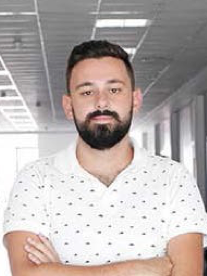Gerdi Papa

XXXII Cycle - (A.A. 2016-2017)
Architecture Technology
Home Institution: Polis University Tirana
Scholarship
Curriculum: Architecture (ICAR12)
Research Topic: Architecture and Technology
Tutor DA-UNIFE: Roberto di Giulio
Tutor Polis University: Antonino di Raimo
Nationality: Albanian
Email: gerdi_papa@universitetipolis.edu.al
Profile
Biography
Born on November 9 th of 1989 in Tirana, Albania, Gerdi is an architect who is passionate about computational and algorithmic design topics as well as digital fabrication. His first steps in the computational design field are taken as his high school education is focused on electronics. He finishes his master studies in Architecture and Urban Design at Polis University in 2014 where he deals with a thesis in Interactive Architecture. His main fields of interest from that point on focus on the digital aspects of designing architecture with a professional master in Parametric Design finished at Polis University in 2016. During this time he also practiced as an assistant lecturer at Polis University in the corses of Information Architecture as well as Computer Aided Design. He started his PhD studies in the joint doctorate program between Polis University and Ferrara in 2016-2017 where he is now developing a thesis on Digital Fabrication and Emergency Shelters.
Research skills
Digital Fabrication | Computational Design | Prototyping | Architecture and Urban Design | Parametric Design
Scientific activities
ORCID ID:
0000-0001-9757-8148
IRIS UNIFE ID:
rp51954
Doctoral research
Digital Fabrication in fast response situations.
The use of digital fabrication, computational design and open source resources as drivers for mass customizable shelters
The main concerns of architects and architecture have always been two: designing and making. Two processes that are in no way mutually exclusive and inform one another during the conceptual and design process, but still two processes which remained largely separated. Robin Evans expanded on the inevitable gap that architects face between the drawing process and the building process or final outcome of their work in his book “Translations from drawing to building”. As he puts it, great invention happens in this gap. Digital practices hold the potential to narrow the gap between drawings and physical products, allowing hypothetically for an almost seamless transition between the designing and the making. Current generations have experienced an evolving architecture practice, with an architecture focused on the expanding formal and material possibilities that the digital age has made possible. Digital methods have fundamentally shifted the architecture discipline to a more interdisciplinary focus. Through the use of digital tools, the process of building and design has been moved to a more accessible and streamlined process. Architects who delve into the digital realm seek to elevate standard building materials through nonstandard fabrication methods and processes. Components can be used to form buildings, and these components can be achieved through smooth undifferentiated expanses, or they can be assembled, constructed, patterned or articulated. Digital Fabrication opens up a sea of possibilities in the realm of manufacturing, with new state of the art tools proving that the process of designing and building can fundamentally be changed. This research will aim to explore the ways in which digital fabrication and computational tools as well as open source design can help to create new digitally designed and fabricated housing models that focus on a fast, low cost, expandable and customizable structures. Seeing as the field of digital fabrication has already established itself as a practice of the present, taking full advantage of what it has to offer in both design, as well as future customization and expansion, and manufacturing is required to elevate design, manufacturing as well as functionality.
Keywords
Digital Fabricaiton | Emergency | Shelter | Fast Response | Adaptable

